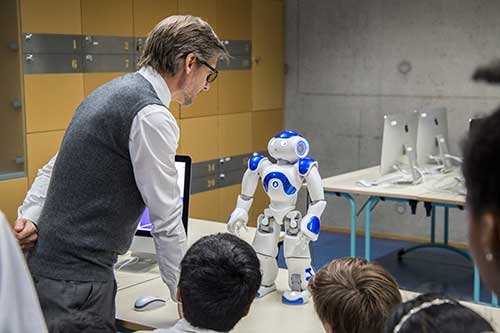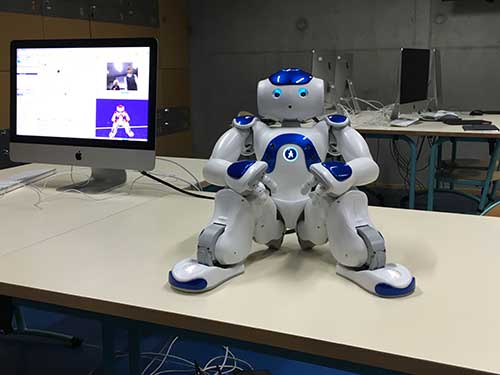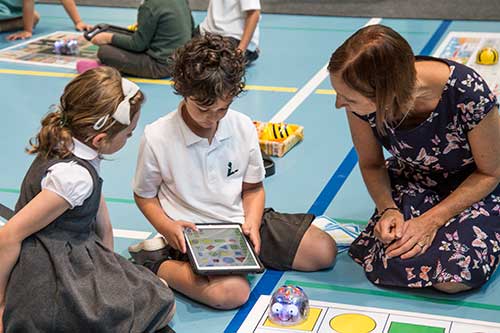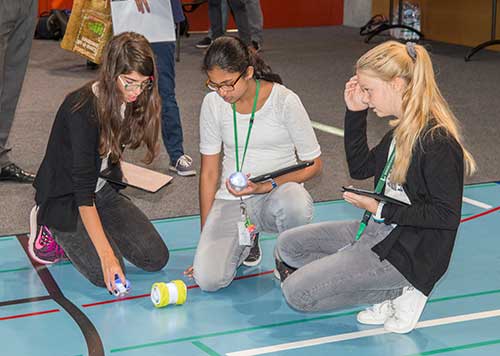
The Institut International de Lancy (IIL) is taking robotics teaching to an exciting new level with the recent acquisition of two new humanoid robots at its campus in Grand-Lancy, Geneva.
Nicknamed, Bonnie and Clyde, the two Nao robots are just the latest examples of progressive learning that the school has introduced since it first started using robotic applications to enhance teaching and learning over twenty-five years ago.
Describing the rationale behind their recent purchases, General Director, Norbert Foerster, told knowitall.ch, “When we first introduced Lego Mindstorm robots into our classroom back in 1991, it soon became apparent that robotics teaching has the unique ability to encourage creativity, collaboration, and communication amongst our students, in a way that traditional teaching techniques can never hope to achieve.”

The skills required by today’s generation of students (known as Generation Z) have been widely discussed in the context of 21st Century Learning. Teachers understand that children need to be more involved in the teaching process and must learn to collaborate with each other more on new projects. They should also be taught through images as well as text, and learn to appreciate the value of feedback when planning ahead.
Foerster explained, “Robotics teaching has a special place is this process. Using robots as a focus for classroom projects helps children to develop problem-solving skills and to understand the benefits of trial and error. Their versatile nature means that robotics can be used by children of all ages, across all teaching disciplines, including Sport, Music, the Arts and Experimental Science.”

At IIL, the youngest children practise counting, sequencing, giving sets of instructions and debugging through a small robotic device called Beebot, and then move on to basic and intuitive coding with Thymio, a robot developed at the Swiss Federal Institute of Technology in Lausanne (EPFL). By the age of 8, children are introduced to app-enabled robots, Ollie and Sphero, both of which are controlled and programmed using iPads. They are used in the programming of motion and velocity, as well as choreographed functions and navigating obstacle courses.
Until the introduction of Nao, Lego Mindstorm V3 was the most advanced robotics tool in the senior school, allowing children to simulate real-word robotic applications such as card-readers, electronic locks and doors, and motorized systems.
However, the humanoid robot Nao takes reflection in the classroom environment to new levels of complexity whereby students can experiment with modular building, and strengthen links with the real world. Nao’s unique capacity to provide feedback sets the stage for students to design programmes that not only influence its behaviour but which can interact with its very environment.

The introduction of Nao has added a whole new dimension to the question of problem-solving amongst students at the school. In the past, coding has been used mainly as a means to learning through reproduction, in situations where the end results are already known. However, with the help of Nao, the school is encouraging students to take on new challenges and to face up to problems that are, as yet, unsolved.
Undoubtedly, this has a huge impact on the role of teachers at IIL, as their students start to move into uncharted territories about which they have no specific experience themselves. IT teacher, Adrian Hirst, told knowitall.ch “We’ve only had the Nao robots and simulation software a few months now, but I’m already starting to see children coming to me with a range of problems about which I have no prior knowledge! At this point, children really have to start thinking for themselves and learn how best to apply the problem-solving skills that they learnt in their early years of working with robots at the school!”
Clearly, the more advanced the robots become at IIL, the more challenging it will be for the teachers as well as the students. It is refreshing to see a school that is prepared to push the boundaries of teaching as well as learning – creating exciting new opportunities for our children in the future.
To give you an example of the kind of skills required by students working with IIL's newest Nao robots, take a look at this wonderful video prepared by the school to celebrate the launch of the 10th anniversary edition of Know-it-all passport!
About IIL
With its origins dating back to 1903, IIL currently has 1500 students divided over two main language sections, English and French. A strong emphasis on languages facilitates bilingual communication throughout the school and aims for a bilingual outcome for all pupils.
An IB World School, IIL is authorised to teach the International Baccalaureate Diploma Programme (IBDP). In addition, it is a Cambridge University examination center and students sit for IGCSE examinations on campus.
As a member of the GESBF (Groupement des Ecoles Suisses qui préparent au Baccalauréat Français) and under the aegis of the Academie de Grenoble, the school also prepares students for the French Baccalaureate and for the Diplôme National du Brevet.
Institut International de Lancy
24, avenue Eugène-Lance
1212 Grand-Lancy
Geneva
School Office: 022 794 26 20
Admissions: 022 884 90 11
Contact: http://www.iil.ch/en/contact-2/
http://www.iil.ch/en









